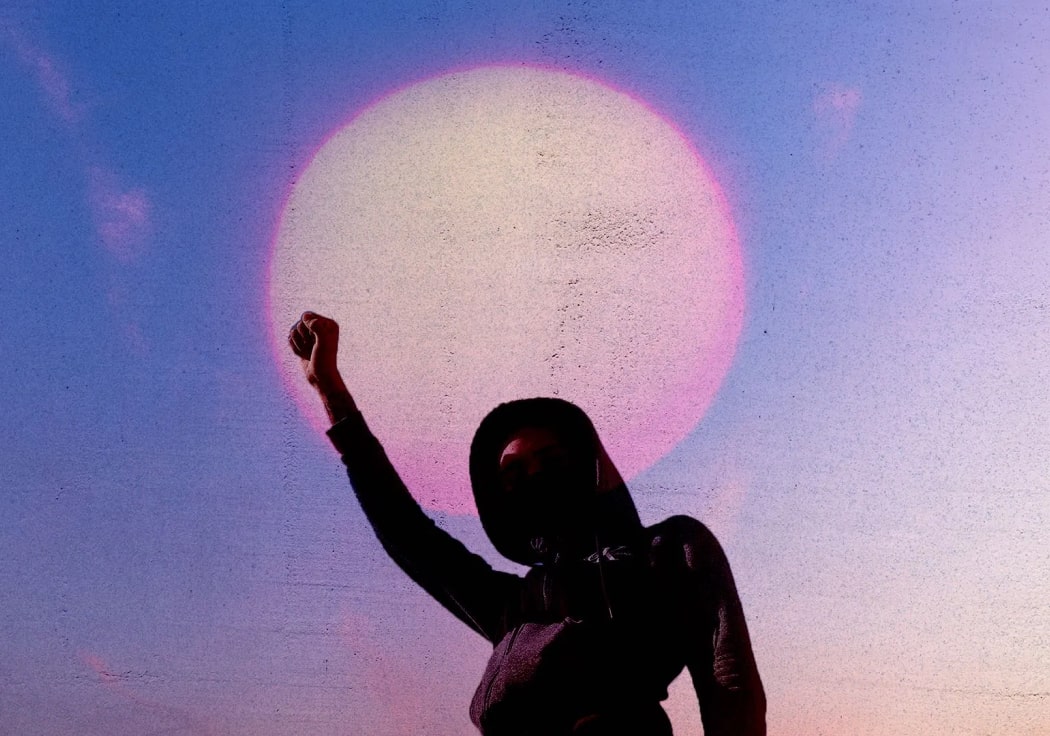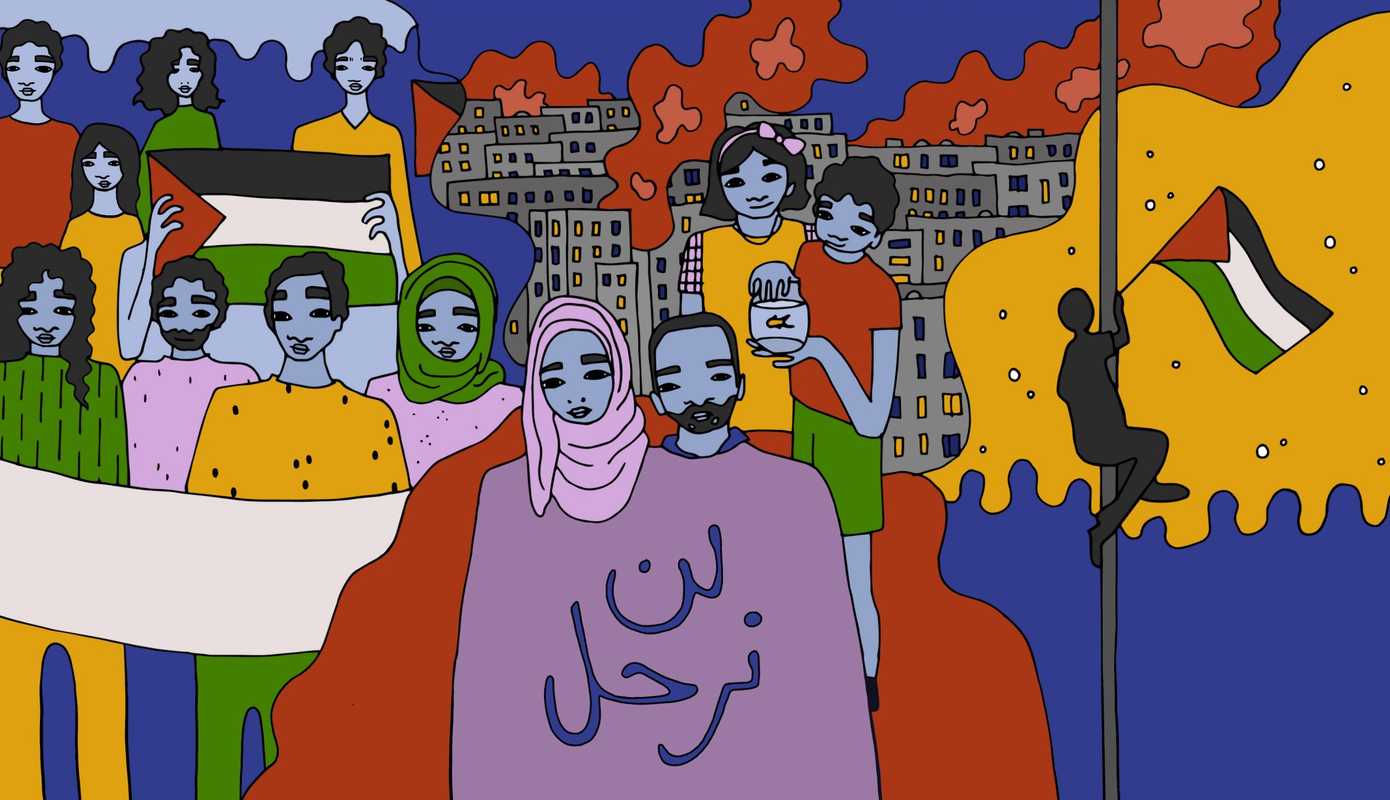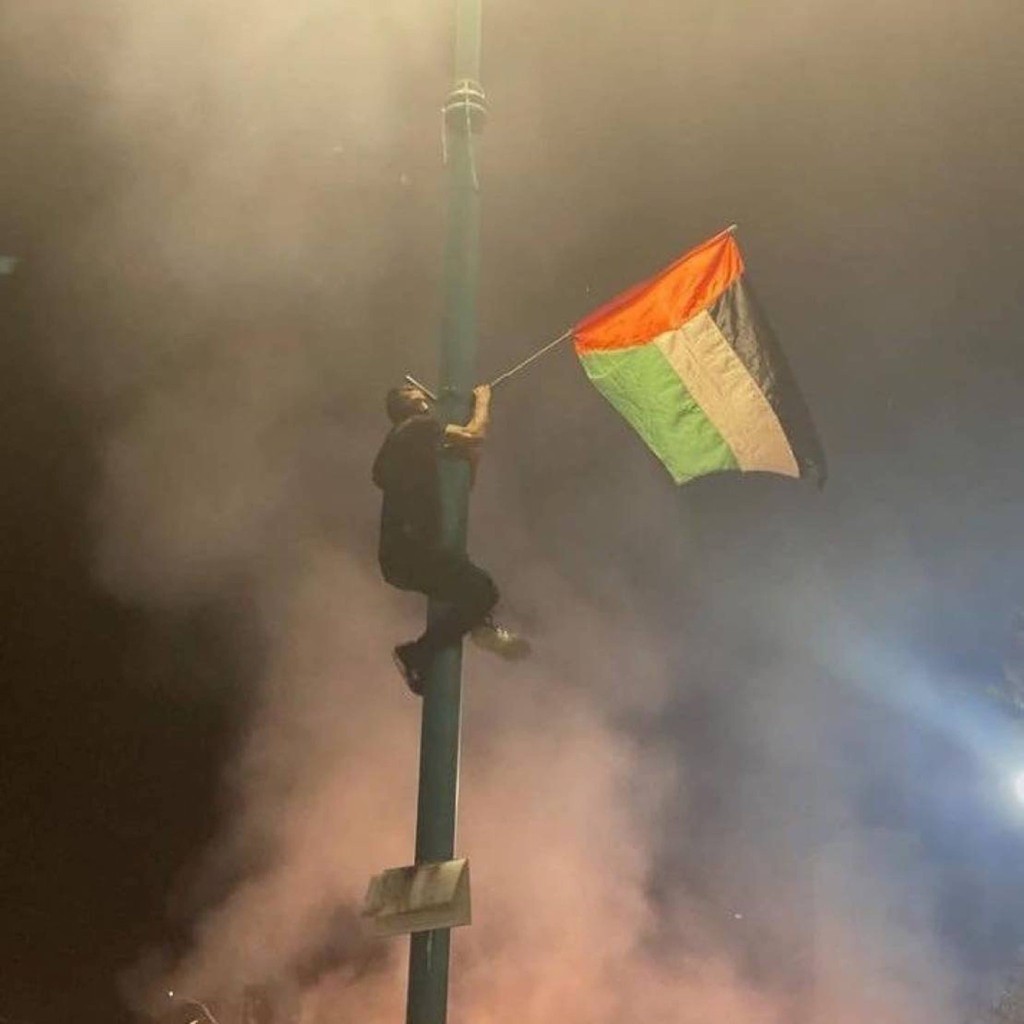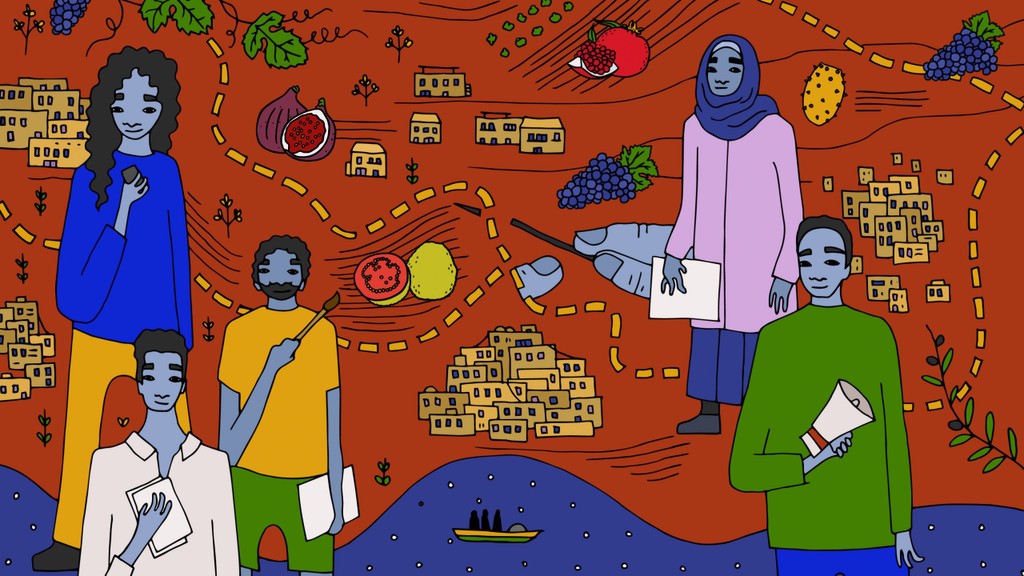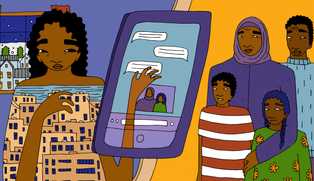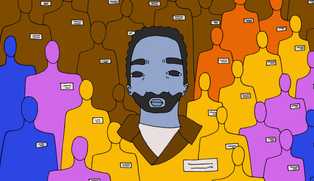This article is part of PALESTINE: WAYS OF BEING, a season centring under-explored areas of Palestinian life and liberation.
In May 2021, a photo was doing the rounds on Twitter. A young man climbs a lamppost in the middle of a protest. Rising above barrels of smoke, he carries the billowing Palestinian flag in one hand. Smoke catches the light from the streetlamps and gives the scene a cinematic feel. The image is slightly blurry, capturing him mid-motion. He’s dressed in black. The only colour in the frame is the vibrant red, green and white of the flag. The man is in Lydda, a Palestinian city under Israeli control since 1948, and this is his freedom cry.
When I see this photo, sheltering from an unexpected rainstorm in Brixton, London, my heart swells in my chest and I am reminded: this is Palestine.
The Nakba, or ‘catastrophe’ in Arabic, refers to the loss of the Palestinian homeland in 1948 and the ethnic cleansing of over 750,000 Palestinians. What happened in Lydda and the neighbouring town of Ramla during the Nakba is the stuff of nightmares. Over four days in July 1948, the new state of Israel launched a brutal offensive on Lydda, killing 426 adults and children, most of whom sought refuge in the Dahmash mosque. Zionist militias then expelled the city’s inhabitants. It is estimated that 50,000 to 70,000 people were dispossessed, residents of Lydda and Ramla alongside many who had arrived seeking refuge from other recently depopulated Palestinian towns and cities. It was the largest single instance of dispossession during the Nakba.
Lydda was a turning point. My friend, whose father was a Lutheran priest in Lydda, tells of how Zionist militias sealed off three exits to the city, leaving one unbarred. The Palestinians of Lydda and Ramla were forced to walk the miles-long road to the West Bank (then under Jordanian control) without food or water. Checkpoints were set up to strip them of any possessions they may have brought from their homes. Many perished on the way, families forced to leave their loved ones unburied on the roadside. I heard this account while living on colonised land in the United States, where forced displacement and ethnic cleansing took place almost a century earlier in the Trail of Tears, and continues to this day.
“Who is left out when we narrate the story of Palestine? What can they tell us about survival, love, liberation, decolonisation?“
If I saw only what was presented to me in the West, I would be forgiven for thinking that Lydda was lost. Its airport has been turned into Ben Gurion international airport, where Palestinians who fly through it from all over the world face harassment, detention and deportation. The surviving Palestinians find themselves living in a ‘mixed city’ under Israeli control – a euphemism for a Palestinian locality which was not totally ethnically cleansed – where they make up only a third of the population. Even its name has been lost: Lydda, now called Lod.
And yet, 73 years later, here was this man in the photograph, this child of Palestine, who has lived his whole life under Zionist settler colonialism. I know our violent history, but I also know what Palestinian resistance looks like. It looks like this man climbing a lamppost in an uprising, clutching a flag of his lost homeland and singing in unison with Palestinians from Haifa to Gaza to Jerusalem to Ramallah, from London to Detroit to Melbourne. It says to me: here we are, still fighting.
The West is used to speaking of Palestine in the past tense, so it was caught unawares by the uprising of May 2021, which brought Palestinians together in search of freedom despite their fragmentation. The Unity Intifada was a watershed moment in how Palestine is seen and understood internationally. Suddenly words like ‘apartheid’ and ‘decolonisation’ – words Palestinians have been using for decades – were catapulted onto a global stage. But it only came as a surprise to those who were not looking.
A year later, in the summer of 2022, we must ask ourselves: what else has been missed? Who is left out when we narrate the story of Palestine? What can they tell us about survival, love, liberation, decolonisation? How can we make sure that Palestine’s many futures ensure everyone’s freedom? The process of decolonisation, as Palestinian scholar Raef Zreik reminds us, cannot be talked about in the past tense: “Talking about it as it occurs means intervening in the shape that it will take, in its trajectory and in its future.”
The pieces in this season are efforts to shape our future. They shed light on three un- and under-explored areas of Palestinian life: queerness, incarceration and Blackness. Looking at where we came from and where we’re going, they expand on some of the ways of being Palestinian today.
Tareq Baconi narrates a queer Palestinian experience in exile. Through shattered fragments, he weaves together memories of his upbringing in Amman, his turbulent time at school, his quest to find his beloved grandmother’s house in Haifa and his dreams of a Palestinian future where no one must hide their true selves.
Read: Dreams of a Palestine where I can hold myself whole
Palestinian futures are also examined in the anonymous contribution from one Palestinian prisoner held in the Israeli carceral state. The writer tells of his childhood hopes and how incarceration, torture and harassment robbed him of making them manifest. His is a tale of the limitations of prison under a settler colonial apartheid regime, but also of the enduring resistance that has come to characterise Palestine.
Read: Living in a time not mine: An anonymous letter from inside an Israeli prison
Then we have two essays on Afro-Palestinian experience. In the first, Mousa Qous introduces us to the Afro-Palestinian community in Jerusalem’s Old City through its residents’ experiences under occupation. The second, a piece from Samah Fadil, is a series of vignettes on life, family and memory in diaspora.
Read: In the heart of the Old City, generations of Afro-Palestinians persevere in the face of occupation
Read: Putting the pieces together: Fragments of oral history in exile
These pieces are not intended to be definitive or authoritative. They are forays into the myriad of Palestinian experiences across the world and under drastically divergent circumstances. What threads them together is their distinctive Palestinian flavour: their resilience and joy in the face of relentless hardship, their ability to boldly imagine another future. They take us on a journey to see Palestine differently: in a way we want to be seen.
Thank you to this season’s contributors for their bravery and generosity, and to the extraordinary editor and translator Laura Albast, and translator Ahmad Barakat. These pieces are only possible due to the generosity of our friends and allies at Skin Deep who have loved and supported this cause from the jump. Lastly, thank you to all those unnamed people who have snatched the name of our homeland from the jaws of history. Who, if they could have, would have given our brother a leg up in Lydda. Thank you for keeping us alive, for teaching us to dream and for showing us all the different ways it is possible to be.
Explore the season in English.
*
At Skin Deep, we make space for Black creatives and creatives of colour to tell radical stories that help usher just new worlds into being. We are a non-profit community interest company and funding is a constant struggle, particularly for some of the issues we believe are the most urgently deserving of our care and attention – like Palestinian liberation. If you believe in the importance of stories like the ones in this season, please support our organisation: become a member, or make a one-off donation.
*
Season credits:
Curator – Zena Agha
Contributing editor – Laura Albast
Skin Deep editors – Nkenna Akunna, Anu Henriques, Hannah Azuonye & Georgie Johnson
Season producer – Hannah Azuonye
Creative director – Sylvia Hong
Illustrator – Aude Nasr
Translators – Laura Albast & Ahmad Barakat
Copy editor (English) – Georgie Johnson
Copy editors (Arabic) – Laura Albast & Ahmad Barakat
Social media manager – Lauren Pemberton-Nelson
Many thanks to MAKAN; European Legal Support Center (ELSC); African Community Society in the Old City of Jerusalem; Danah Abdulla & Megan Driscoll for all your support with this season.
*
A note on language: Throughout this season we use the terms ‘settler colonialism’ and ‘apartheid’ in reference to Israel. These terms are not employed solely for creative or descriptive purposes, but have a clear basis in international law and are supported by academic publications and leading human rights organisations. These frameworks encourage us to move away from the defunct ‘two state’ model which is predicated on partition and ethno-religious separation of people. Justice and freedom lie at the heart of our work and we have been listening to Palestinian thinkers and scholars who imagine their future as a decolonial one, where decolonisation means the repatriation of indigenous land and life. In order to further this vision, it is important to use accurate and detailed language which reflects the reality on the ground.
Further reading on these terms and ideas:
Abdo, Nahla and Yuval-Davis, Nira (1995), ‘Palestine, Israel and the Zionist Settler Project’, in D. Stasiulis, and N. Yuval-Davis (eds), Unsettling Settler Societies: Articulations of Gender, Race, Ethnicity and Class, SAGE.
Jabary Salamanca, Omar, Mezna Qato, Kareem Rabie & Sobhi Samour (2012) Past is Present: Settler Colonialism in Palestine, Settler Colonial Studies, 2 (1): 1-8.
Said, Edward (1979). Zionism from the Standpoint of Its Victims. Social Text, (1), 7-58.
Veracini, Lorenzo (2006) Israel and Settler Society, Pluto Press.
Ilan Pappe, “Zionism as Colonialism: A comparative view of Diluted Colonialism in Asia and Africa” South Atlantic Quarterly (2008) 107 (4): 611–633.
Jong, Anne de. “Zionist Hegemony, the Settler Colonial Conquest of Palestine and the Problem with Conflict: A Critical Genealogy of the Notion of Binary Conflict.” Settler Colonial Studies 8, no. 3 (2018/07/03 2018): 364-83. https://doi.org/10.1080/2201473X.2017.1321171.
Kauanui, J Kēhaulani. “‘A Structure, Not an Event’: Settler Colonialism and Enduring Indigeneity.” Lateral 5, no. 1 (2016): 5-1.
Tuck, Eve, and K Wayne Yang. “Decolonization Is Not a Metaphor.” Decolonization: Indigeneity, education & society 1, no. 1 (2012).
Patrick Wolfe. “Settler Colonialism and the Elimination of the Native.” Journal of Genocide Research 8, no. 4 (2006/12/01 2006): 387-409. https://doi.org/10.1080/14623520601056240.
